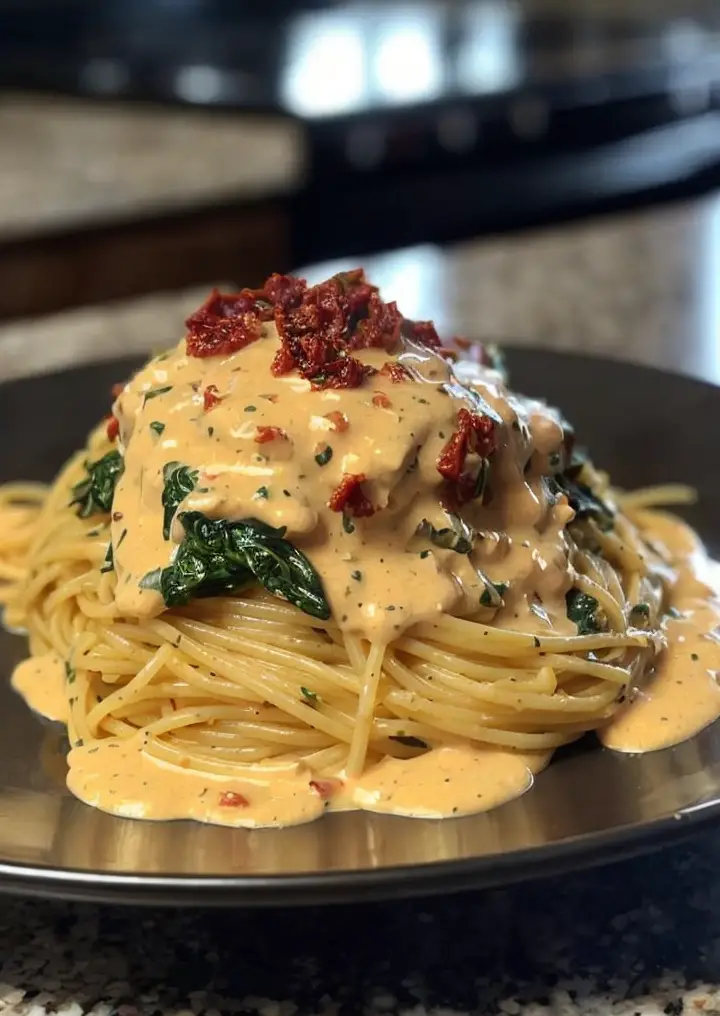Spaghetti & Spinach with Sun-Dried Tomato Cream Sauce: A Delicious Twist on Pasta
Embark on a culinary journey with Spaghetti & Spinach with Sun-Dried Tomato Cream Sauce. This delectable dish marries the vibrant flavors of sun-dried tomatoes with the creamy textures of a luxurious sauce, all perfectly hugging al dente spaghetti. The subtle sweetness of the sun-dried tomatoes intertwines with the earthy notes of fresh spinach, creating a nutritious and flavor-packed meal.
Imagine the comfort of a creamy pasta dish that doesn’t compromise on freshness or zest. With its velvety sauce and nourishing spinach, this meal is a feast not only for your taste buds but also for your soul. Whether it’s a family weeknight dinner or a small gathering with friends, this pasta creation is bound to captivate your guests with its elegant simplicity and unmatched flavor.
Quick Recipe Highlights
- Flavor Profile: A rich blend of tangy sun-dried tomatoes coupled with a creamy, decadent sauce that brings balance to the dish.
- Texture: Silky smooth sauce coating well-cooked spaghetti, with tender spinach woven throughout, offering delightful bites.
- Aroma: Aromatic notes of garlic and herbs meld with the sweet scent of sun-dried tomatoes, creating an inviting fragrance.
- Visual Appeal: A stunning dish showcasing vibrant green spinach amidst a rich cream-colored sauce dotted with sun-kissed tomatoes.
- Skill Level Needed: Basic cooking skills are sufficient; the dish requires attention to detail for the sauce.
- Special Equipment: A good quality skillet and pasta pot are essential to achieve the perfect texture and sauce consistency.
Recipe Overview
- Difficulty Level: This dish is categorized as medium difficulty due to the sauce’s precision and pasta’s readiness consistency.
- Category: Ideal as a main course dish, it can also serve as an impressive offering in a multi-course meal.
- Cuisine: This pasta dish carries Italian influences with a modern twist that caters to contemporary taste preferences.
- Cost: A budget-friendly meal as it utilizes pantry staples, fresh greens, and a bit of indulgence with cream and tomatoes.
- Season: Perfect for spring and summer as the vibrant ingredients are in bloom, though equally comforting in colder months.
- Occasion: A versatile dish that suits everything from family weeknight dinners to more formal occasions with equal appeal.
Why You’ll Love This Recipe
Savor the taste and texture appeal of the creamy sauce clinging to strands of spaghetti, accentuated by the bursts of flavor from sun-dried tomatoes. This dish is a delightful blend of comfort food and gourmet indulgence that will leave your palate wanting more.
The convenience of this recipe lies in its straightforward preparation and the minimal use of complex kitchen equipment. Even with a busy schedule, you can whip up a nutritious meal that feels like a rewarding culinary experience.
Nutritionally, this dish offers a rich supply of vitamins from the spinach, alongside an energy-boosting carb from the pasta. It manages to combine indulgence with health, offering a satisfying meal without unnecessary guilt.
Socially, Spaghetti & Spinach with Sun-Dried Tomato Cream Sauce shines as a conversation starter at gatherings. Its blend of flavors and attractive presentation makes it a perfect shared meal, fostering connections one bite at a time.
Cost-effectiveness and accessibility are intrinsic to this recipe. Leveraging easily obtainable ingredients, you can enjoy a restaurant-quality meal at home, making it possible to dine marvelous without the extravagant price tag.
Historical Background and Cultural Significance
Spaghetti, an iconic pillar of Italian cuisine, lays the foundation for this dish. Its history dates back to ancient Rome, where pasta slowly evolved to its modern-day iterations, beloved across the globe. Pairing it with a cream sauce pays homage to the rich sauces that define many traditional Italian dishes.
Sun-dried tomatoes, once a method to preserve fresh produce in the sunny regions of Southern Italy, lend this recipe a deep cultural significance. Their bold and tangy flavor is a testament to culinary creativity in utilizing available resources.
The evolution of cream sauces in Italian cuisine reflects the blend of unctuousness with fresh ingredients, a hallmark of balanced Italian cooking. This adaptation focuses on emphasizing healthful greens such as spinach while maintaining the creamy base signature.
Culinary regionality encourages variations where local ingredients find a place within classic recipes. Thus, while spinach features prominently here, other regional greens might substitute, reflecting local tastes and seasonal availability.
Ingredient Deep Dive
Sun-dried tomatoes are cherished in Italian cooking for their concentrated flavor and lengthy shelf-life. Historically, sun-dried tomatoes allowed for consumption of summer bounty throughout the year, enhancing dishes with their intense taste.
Nutritionally, sun-dried tomatoes are antioxidant-rich, providing lycopene and other vital nutrients. When selecting, look for pliable yet firm pieces; they should be bright with a strong tomato aroma indicating quality. Store in a cool, dry place to maintain their bold flavor.
Spinach carries its weight culturally as both a staple and a nutritious powerhouse. Full of iron, vitamin C, and antioxidants, it offers substantial health benefits, important for balance within hearty meals.
Select vibrant, fresh spinach, ideally without signs of wilting. For storage, keep it dry and refrigerated, consuming it within a week for maximum freshness. Frozen spinach serves as an excellent substitute, retaining nutrients and easing preparation.
Common Mistakes to Avoid
- Overcooking the pasta, leading to a mushy texture. Always cook to al dente following package instructions.
- Neglecting to season the pasta water, which adds flavor depth. Salt generously for optimal taste.
- Rushing the sauce, which results in an unbalanced flavor. Allow ingredients to meld for perfect creaminess.
- Using inferior quality sun-dried tomatoes, affecting the dish’s flavor intensity. Invest in premium ingredients for the best result.
- Forgetting to reserve pasta water, which helps in achieving a perfect sauce consistency.
- Undercooking spinach, which may lead to a raw, uninviting taste. Lightly wilt for the best texture.
- Allowing sauce to over-reduce, making it too thick. Monitor closely and adjust heat as necessary.
- Starting with cold ingredients, which can prolong cooking times and affect taste. Ensure all ingredients are at room temperature before beginning.
Essential Techniques
Mastering pasta’s cooking requires vigilance and tasting for that perfect al dente bite. It’s crucial to understand the transformation of grains into pliable noodles without tipping into over-saturation.
Cream sauce precision is vital, particularly in balancing creaminess with the sundry flavors of tomatoes and herbs. Don’t rush the process; allow each ingredient its time to shine within the sauce.
Heating spinach uniformly is essential to extract not only texture but inherent flavors as well. Wilt your greens gently for an optimal mouthfeel, yielding depth without overwhelming.
Visual cues help ensure the perfect consistency in your sauce. Aim for a silky appearance and flawless adherence to the spaghetti, showcasing a glossy sheen without any clumping.
Pro Tips for Perfect Spaghetti & Spinach with Sun-Dried Tomato Cream Sauce
Ensure your sun-dried tomatoes soak ahead of preparation, softening to achieve an even blend within the sauce.
Add a splash of lemon juice or zest to the finished dish for an added burst of brightness, which complements the richness of the cream sauce.
For a deeper flavor profile, incorporate freshly chopped herbs like basil or oregano towards the end of the cooking process.
Toast your spaghetti slightly post-cooking for an added nutty undertone, elevating the dish’s complexity.
Experiment with cheese alternatives, such as a sprinkle of pecorino romano instead of parmesan, for distinct saltiness.
If a thicker sauce is desired, incorporate more reserved pasta water gradually, adjusting consistency to your preference.
Variations and Adaptations
Regional variations might substitute spinach with equally nutritious greens, such as kale in Mediterranean versions, providing a robust twist to the dish.
Embrace seasonal adaptations with veggies like zucchini blossoms in summer, adding vibrancy and refreshing new textures to the pasta.
Dietary modifications are readily achievable by swapping traditional cream with a plant-based version, making the meal suitable for vegan preferences without losing its signature depth.
Enhance flavor variations by incorporating chili flakes for a spicy kick or roasted red peppers for added depth to your sauce’s complexity.
Textural modifications can involve adding a crunchy crumble of seasoned bread crumbs or toasted pine nuts, providing contrast to the creamy pasta.
Presentation alternatives include twirling the spaghetti into individual nests, adding height and elegance to the plate, capturing a sophisticated dining atmosphere.
Serving and Presentation Guide
Experiment with plating techniques by creating a volcano mound of pasta on center plates, drizzling sauce artfully around the edges for an artistic touch.
Garnishing ideas can include fresh basil leaves, sun-dried tomato slivers, or a sprinkle of crushed black pepper to enhance visual allure and hint refreshingly bold flavors.
Traditional accompaniments like a simple arugula salad with a lemon vinaigrette play beautifully against the rich pasta flavors, balancing the density with crisp layers.
Modern serving suggestions embrace communal bowls, allowing for family-style sharing and embracing sociable dining traditions accentuated by this adaptable dish.
Temperature considerations emphasize serving immediately for best indulgence, ensuring sauce consistency remains impeccable alongside warm pasta strands.
Portion control tips suggest arranging servings in a star pattern on a larger platter, which assists in mindful dining while still indulging guests with stunning visual complexity.
Wine and Beverage Pairing
Pair this pasta with a bright, unoaked Chardonnay whose crisp notes contrast nicely with the cream sauce’s richness, cleansing the palate of excess dairy.
For a non-alcoholic alternative, try a sparkling water flavored with lime or mint, heightening freshness to counterbalance hearty pasta meals.
Coffee or tea pairings can enhance the end of a dining experience, with an espresso offering a robust contrast or a chamomile tea bringing calming flavors to counteract any richness.
Temperature considerations suggest serving wines slightly chilled, especially whites or sparklings, to maintain refreshing qualities against the pasta’s warm colors.
Serving suggestions include opting for glasses with wider mouths, particularly those that maximize aroma dispersion to emphasize wine complexity alongside your pasta creation.
Storage and Shelf Life
Store leftovers in an airtight container, ensuring minimal exposure to air to maintain flavors at their peak freshness for up to 3 days in the refrigerator.
Temperature requirements emphasize cooling the dish fully before sealing, as it prevents condensation build-up contributing to waterlogging when transformed into storage.
Container recommendations include glass or BPA-free plastic, providing a clean vessel that keeps odors from permeating and resisting flavor transference effectively.
Signs of spoilage revolve around off aromas or significantly altered colorations, indication enough to dispose of for safety.
Reheating instructions suggest employing microwave-safe dishes or stovetop methodologies, remobilizing any cream sauce with gentle heat additions like milk for optimal texture recovery.
Freezing guidelines convey possibilities but caution against potential sauce separation. Freeze in one-portion sizes if desired, defrosting gently and remixing flavors diligently before serving.
Make Ahead Strategies
A prep timeline breaking down components a day or two in advance can lighten load; spinach washing and tomato chopping lend notable efficiency.
Consider storage between steps; partially prepare the sauce and refrigerate two days before finishing. Assemble when needed, knocking a significant portion off your cooking time.
Quality impact assessment confirms flavor intensifies with refrigerator rest, paving the way for improved integration when planned accordingly.
Assembly tips encourage reheating sauce gently before recombining with fresh pasta for an instant dinner solution, retaining optimal taste.
Reheating guidelines highlight microwaving or stovetop methods across low-medium heat for gentle resuscitation without losing sauce lusciousness or integrity.
Fresh element additions suggest infusing additional herbs just prior to serving, amplifying freshness no matter how far ahead initial preparation occurred.
Scaling Instructions
Halve the recipe easily by reducing each ingredient proportionally, mindful of pasta amounts aligning with desired servings without sacrificing robustness.
Doubling or tripling carries benefits for larger groups but requires extended attention on texture to merge increased quantities without losing sauce vibrancy or cohesion.
Equipment adjustments advocate for proportionally larger pots or skillets to achieve adequate cooking surface areas, ensuring regularity across extended family-style portions.
Timing modifications, in-batch preparation for pasta or sauce components further streamline operations without deterring quality.
Storage considerations articulate preserving remaining goods in diverse container options, attempting tight storage conditions to prolong life when dealing with vast quantity preparations.
Nutritional Deep Dive
Macro breakdown characterizes balanced carbohydrates courtesy of spaghetti colliding with healthy fats through creamy sauces, noting dietary satisfaction pursuits.
Micronutrient analysis celebrates vital contributions like spinach’s iron and vitamin C, supporting bodily functions while enhancing overall energy levels post-consumption.
Health benefits arise through incorporation of tomato’s lycopene, and antioxidants loaded within spinach, advocating heart health while diminutive reductions on dietary concerns.
Dietary considerations acknowledge creamy ingestion may conflict with certain lactose-restricted diets – gauging cream replacements to maintain dish integrity.
Portion analysis, relying on a pasta base, complements bulking but demands moderation; consider serving size limitations meeting nutritional guidelines appropriately.
Weight management tips postulate observing one-seventh servings for confidence in dietary compatibility and self-control, striking a successful nutritional balance.
Dietary Adaptations
For a gluten-free version, substitute traditional spaghetti with gluten-free pasta, ensuring all other ingredients adhere to safe dietary practices.
For a dairy-free modification, swap cream with a plant-based variant like coconut or almond cream, achieving a similar juxtaposition texture without negatively impacting flavor.
Vegan alternatives involve selecting nutritional yeast for cheese elements while omitting any animal-derived components, maximizing plant-based integrity.
Low-carb adaptation includes zucchini noodles as a pasta substitute, re-imagining dish outlines around carb reduction without forsaking influence from the sauce’s identity.
Keto guidelines accommodate by focusing on higher fat content creams and a controlled intake of alternative, less composed noodle options, aligning better with the diet’s foundation.
Paleo selections accentuate vegetable bases interpreting the dish through organic components only, maintaining flavor symposium without deviation.
Low-FODMAP paths navigate by employing selective ingredients for reduction in specific fermentable carbohydrate structures, challenging but feasible through guided alternate options
Troubleshooting Guide
Should you encounter texture issues, begin with observing pasta cooking intent closely, adjusting water to tenderness equilibrium addressing any misalignments.
Flavor balance might waver; temper cream and spices by incrementally adjusting each component by taste to regain harmony among competing culinary elements.
Temperature problems manifest in cold ingredients entering a hot preparation process; pre-warm or standardize ingredient temperatures facilitating smoother dish execution.
Equipment challenges often stem from inadequate gear size; scale solutions revolve around matching capacity to cooking requirements while overseeing safety margins.
Ingredient substitutions may inadvertently alter dish structure; ensure respective replacements maintain harmonizing role functions or face outcome variations.
Timing concerns refine as core resolution by tracking preparation times diligently, avoiding laborious waits or complications, guarding final presentation steadfastly throughout cooking routines.
Recipe Success Stories
Community feedback applauds the dish for bridging flavor with accessibility, allowing even novice cooks a chance at gourmet success without cognitive or exotic ingredient barriers.
Variation successes documented by readers attest to creativity with fresh herbs or indulgent cheese incorporations, tailoring enhancements to personal taste preferences yielding satisfaction.
Adaptation stories detail friends and family gatherings impressed by adjusted versions free for dietary restrictions, maintaining integrity while reinforcing universal accessibility.
Reader suggestions illustrate incorporation of shrimp, roasted chicken, or equivalent protein augmentations yielding balanced meal structures resonating beyond vegetarian limitations.
Photography tips from contributors articulate appreciation for natural lighting benefits accentuating vibrant pasta and sauce aesthetics, aspiring all to venture into attractive publication avenues.
Frequently Asked Questions
Can I use fresh tomatoes instead of sun-dried tomatoes?
Yes, fresh tomatoes can be used, but note that they will alter the flavor profile and texture. You may need to cook them longer to achieve desired taste and rich consistency similar to sun-dried tomatoes.
How do I make this dish ahead of time?
Prepare the sauce in advance and store it in the refrigerator for up to 2 days. Simply reheat gently and combine with freshly cooked pasta when you’re ready to serve. This approach retains flavor without hastening last-minute preparation.
What can I substitute for spinach?
Consider arugula or kale as suitable alternatives to spinach. Each offers a unique taste while preserving the dish’s nutritional benefits. Remember to adjust the cooking time accordingly to maintain greenery freshness.
Is there a vegetarian option for parmesan cheese?
Nutritional yeast or dairy-free store offerings present a cheese alternative, providing an equally savory component without reliance on animal-based derivatives.
Can I use any type of pasta for this recipe?
Spaghetti works best due to its smooth surface for sauce adherence. However, penne or fettuccine can also function, providing they are cooked accordingly to ensure similar enjoyment in texture and taste.
How should I adjust the cooking time for gluten-free pasta?
Gluten-free pasta often requires less boiling time. Follow package instructions for timeline optimization. Taste-testing throughout boiling compliments ensemble development and precise consistency realization.
What protein can I add to suit non-vegetarian preferences?
Grilled chicken or sautéed shrimp can enhance the meal, complementing the creamy sauce harmoniously. Ensure proteins are adequately seasoned and cooked separately before integrating just prior to final serving.
Why is my sauce curdling, and how can it be fixed?
Curdling can result from rapid heating or incorporating cold cream into hot mixtures. To remedy, slowly introduce dairy over moderate heat, stirring consistently to prevent temperature oscillation, thus safeguarding sauce consistency.
Are there any low-fat substitutes for cream in this recipe?
Try using Greek yogurt or light sour cream as feasible substitutes, managing texture with additional pasta water if desired due to differences in consistency between standard creams of recipe index.
How do I thicken the sauce if it turns out too watery?
Adding simmer time can naturally reduce sauce liquid quantity. Alternatively, utilize cornstarch slurry seamlessly incorporating into sauce volumes for thickening without affecting taste profiles.
Can this recipe be made without garlic?
Garlic-free versions are achievable, relying on alternative herbs like chives or shallots for aromatic depth, ensuring the overall flavor profile derives from rich tomato and cream base highlights.
Additional Resources
Explore related recipes like Creamy Tomato Basil Pasta or Sun-dried Tomato Pesto for similar flavor palettes with unique culinary narratives driving enticing conversions between family experiences.
Technique guides elaborate on defining moment entrees like fresh tomato blanching or garlic roasting, crafts deserving visualized recognition appealing to passionate home chefs.
Ingredient information dives deep into appreciated tomatoes or creamy philosophy debates, delving into why certain emulsions work over others amongst witting matrices.
Equipment recommendations revolve around endorsements like non-stick pan excellence, differentiating between cookware brands ensuring superior finishing throughout meal preparation.
Seasonal variations highlight ingredients punctuating transitions between spring vibrance or fall substance through particular vegetable selections tailored towards climate-driven preferences.
Join the Conversation
Engage with us on social media by sharing your culinary results and tagging us to join our delightful community celebrating a multitude of shared experiences.
Photography tips stem from daily discoveries, such as natural lighting devotion endorsing sunlight’s grace amplifying clarity and detail among eye-pleasing harvest meals.
Recipe reviews voice encouragement, fostering thoughtful elucidation, channeling others towards embarking on this culinary journey customizing beloved parameters or frameworks.
Community engagement encompasses narrative sharing post-development avenues as reflectively enlightening as the recipes themselves, uniting enthusiasts through ongoing discourses.
Recipe variations embolden endless interpretations, accommodating individuality’s emblem pure in essence, steering vibrant visionaries towards further honors substantively impactful yet uniquely theirs.
The Recipe
Spaghetti & Spinach with Sun-Dried Tomato Cream Sauce
Serves: 4
Prep Time: 15 mins
Cook Time: 20 mins
Total Time: 35 mins
Kitchen Equipment Needed
- Large pot for boiling pasta
- Skillet for sauce preparation
- Strainer or colander
- Medium-sized mixing bowl
- Wooden spoon or spatula
Ingredients
- 12 oz spaghetti
- 1 cup sun-dried tomatoes, thinly sliced
- 2 cups fresh spinach, washed and trimmed
- 1 cup heavy cream
- 2 cloves garlic, minced
- 1/2 cup grated parmesan cheese
- Salt and pepper to taste
- 2 tbsp olive oil
- 1/4 cup reserved pasta water
- Optional: fresh basil for garnish
Directions
- Bring a large pot of salted water to a boil and cook the spaghetti according to package directions until al dente. Reserve 1/4 cup of pasta water, and drain spaghetti.
- In a large skillet over medium heat, warm olive oil and gently sauté garlic until fragrant, about 1 minute.
- Add sliced sun-dried tomatoes to the skillet, stirring occasionally, until heated through and slightly soft.
- Pour in heavy cream, stirring to combine thoroughly with the tomatoes and garlic.
- Reduce heat to low, adding the spinach and stirring gently until wilted.
- Toss the cooked spaghetti with the sauce, adding reserved pasta water as needed to reach desired sauce consistency.
- Stir in grated parmesan cheese, adjusting seasoning with salt and pepper as desired.
- Serve hot, garnished with fresh basil if using.
Recipe Notes
- For a spicier kick, add a pinch of red pepper flakes during the garlic sautée.
- To make it gluten-free, substitute spaghetti with your choice of gluten-free pasta.
- Store leftovers in an airtight container in the refrigerator for up to three days for best quality.










